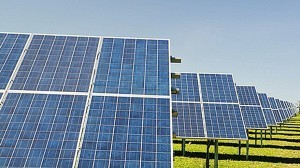Even a sustainable circular economy cannot run without energy. Solar plants and wind farms, tidal and geothermal power plants: they all divert energy from energy flows that have remained untouched since time immemorial. The question is therefore: what proportion of these energy flows can humanity use for its own purposes without damaging the Earth's energy system?
The earth has its limits, as we are becoming increasingly aware in view of the climate crisis, the increasing extinction of species and the littering of the oceans (and even outer space) as a consequence of human activity. As a possible response to this, governments and institutions around the world are promoting the concept of the circular economy. By closing material cycles, the environmental impact associated with the extraction of raw materials is to be avoided and the waste problem solved. However, in terms of a sustainable society, this approach alone is not enough, as it leaves open the question of how much and how quickly materials are recycled and what energy is used to operate these cycles. In a truly sustainable society, not only the material flows but also the energy flows must remain within the limits set by our home planet.
Energy for the operation of the earth
 Empa shows the way: Harvesting solar energy on all roofs and facades - it can be done. The NEST Unit Solace has no roof surface. It only harvests electricity and heat through its turquoise façade A central question is therefore: Is there enough renewable energy available globally for the sustainable design of material flows in our society without exceeding planetary boundaries? An Empa team led by Harald Desing from the Technology and Society department is investigating this question. If we consider planet Earth as a system, it only exchanges energy with its environment. The vast majority of the energy introduced into the system is solar radiation, supplemented by small amounts of planetary kinetic energy and geothermal energy. These energy flows have always been fully utilized by the Earth itself. Its many subsystems, such as the oceans, the atmosphere and forests, but also reflective ice surfaces, have thus been kept in operation to a certain extent.
Empa shows the way: Harvesting solar energy on all roofs and facades - it can be done. The NEST Unit Solace has no roof surface. It only harvests electricity and heat through its turquoise façade A central question is therefore: Is there enough renewable energy available globally for the sustainable design of material flows in our society without exceeding planetary boundaries? An Empa team led by Harald Desing from the Technology and Society department is investigating this question. If we consider planet Earth as a system, it only exchanges energy with its environment. The vast majority of the energy introduced into the system is solar radiation, supplemented by small amounts of planetary kinetic energy and geothermal energy. These energy flows have always been fully utilized by the Earth itself. Its many subsystems, such as the oceans, the atmosphere and forests, but also reflective ice surfaces, have thus been kept in operation to a certain extent.
Most of these subsystems convert the incoming energy into further renewable energy flows, for example wind and water currents or biomass production. In the process, free energy, known as exergy, is extracted from the incoming energy flows. Regardless of the use, whether in the natural earth system or the man-made technosphere, all the energy is ultimately radiated back into space.
Solar parks also change the climate
If humanity increasingly diverts portions of renewable energy flows for its activities, the portions available to the Earth system will be reduced. The Earth system can compensate for such disruptions to a certain extent. However, if they are too great, the risk of exceeding so-called tipping points increases. This would result in rapid and irreversible changes to the Earth system, such as the melting of the polar ice caps, which in turn would accelerate climate change. In order not to exceed these tipping points, the size of the land area used must not exceed the planetary load limit. However, the way in which the land is used is also crucial: Solar plants instead of forests, for example, disrupt biodiversity, evaporation and thus the water cycle, the re-radiation of heat into space and much more.
The same upper limits as for solar use also apply to the harvesting of so-called chemical energy - i.e. for agriculture and forestry, which produce food and animal feed, heating material, fuels and building materials. In many areas, the production of technical energy competes with food production.
Electrical energy as a universal currency
In order to be able to compare or add up the various renewable energy potentials, the Empa researchers have converted them into electrical energy equivalents. The calculations are based on the efficiency of currently available power plant technology. It makes a difference whether electricity is generated from solar energy, wood or hydropower. These conversion losses further reduce the possible harvesting of some potentials considerably.
The result of the study is surprising: 99.96% of the energy arriving on Earth from space is needed to power the Earth system and food production, so only 0.04% can be used technically. Nevertheless, this potential is still around ten times higher than today's global energy demand.
The result of considering the conversion losses is hardly surprising: we should preferably harvest and use the available energy using solar cells. After all, almost all renewable energy resources - including wind power, hydropower and biomass production - are ultimately powered by the sun. Direct use of solar energy means fewer conversion steps and therefore fewer losses.
Photovoltaics on all sealed surfaces
 So just build masses of solar systems and the energy problem is solved? Of course, it's not quite that simple . A large proportion of solar energy could be harvested on a small part of the earth's deserts, but this is technically and logistically complex. The research team from the Technology and Society department therefore views solar energy harvested from desert areas as a global energy reserve in the event that all other harvesting options have been exhausted.
So just build masses of solar systems and the energy problem is solved? Of course, it's not quite that simple . A large proportion of solar energy could be harvested on a small part of the earth's deserts, but this is technically and logistically complex. The research team from the Technology and Society department therefore views solar energy harvested from desert areas as a global energy reserve in the event that all other harvesting options have been exhausted.
As a consequence, we should start using all the surfaces that are already sealed worldwide, e.g. building roofs and facades, but also roads, railroads and parking lots. This area would be sufficient to supply a global 2000-watt society.
However, if global energy requirements were to be raised to the level of current Swiss per capita requirements, desert areas would also have to be used. All other energy potentials (e.g. from wind or biomass) are orders of magnitude smaller than the direct use of solar energy - and some of them are already overused. Nevertheless, they can play an important role locally, especially because they can reduce the need for storage capacities - a problem that has not been taken into account in this study.
So just build masses of solar plants and the energy problem is solved? Of course, it's not quite that simple. In their study, the Empa team only looked at the first step - calculating the available energy potential. The actual amount of energy available will be smaller: limiting factors include the availability of raw materials, but also financial capital and manpower, the environmental impact of raw material extraction or production, operation and disposal of the systems, as well as the need for additional infrastructure for energy distribution and storage.
The research team is currently investigating the question of what such a path from a fossil to a solar society might look like. After all, the solar energy system must not only be large enough to meet global demand, it must also be able to replace the fossil fuel system quickly enough to avert a climate catastrophe in time.


